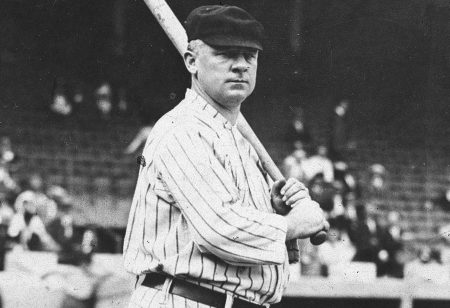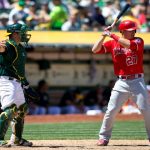Common Law Origins of the Infield Fly Rule
 Fans hardly ever hear an announcer declare the umpires have just called the infield fly rule. Does the ordinary fan have any idea that the infield fly rule is called when first and second, or first, second, and third bases are occupied before two are out?
Fans hardly ever hear an announcer declare the umpires have just called the infield fly rule. Does the ordinary fan have any idea that the infield fly rule is called when first and second, or first, second, and third bases are occupied before two are out?
Probably not.
And what about the history behind the rule?
Again, probably not.
The wild west nature of early baseball when the game had yet to become the game we know today and the infield fly rule was desperately needed to signal baseball could still be a fair and honorable game fans could believe in?
Again, probably not.
An Aside
In June 1975, The University of Pennsylvania Law Review published a short legal argument, called an Aside, The Common Law Origins of The Infield Fly Rule. It was written by William Stevens, who painted a convincing sketch of baseball as an arena where the process of drawing up an orderly rule that drew upon the ideas of common law.
So, the Aside has something to say about rule formation. Let’s review why baseball is in this picture.
In the Beginning, the National Pastime was …
… all about a healthy afternoon in the sun on a grassy knoll where wealthy men played amateur baseball for gentlemanly pleasure and exercise after 1845. They did not play to win.
The values of amateur baseball then changed dramatically over the next 20 years before the onset of the Civil War.
In 1857 the first amateur league was formed, the National Association of Professional Base Ball Players. It was called the Amateur Association. A 16-team league of wealthy men playing the game for exercise and sportsmanship, centered around the New York City area.
At first, it was a successful league until gamblers pounced. Gamblers changed the game in their image. Meaning winning and money began to matter most. They began hippodroming, or fixing games, with players’ help. And with hippodroming came not only a new set of corrupt values but the gradual dismantling of the Amateur Association.
Some players received direct payments from gamblers. Other times enterprising officials put an entire team of ballplayers on a city payroll, so the city paid their salaries. Boss Tweed’s New York Mutuals, an amateur team, was on the New York City dole. No matter how it was done, amateurs began making money, every week.
Needless to say, this illicit money undermined public trust in the rectitude of the game. And as this trend grew, the Amateur Association became more about money and winning, and less about sunshine, exercise and recreation. Fans no longer believed in the honesty of the scheduled contests. They believed their eyes.
Then there were the revolvers or players who agreed to play for a team and even accepted money up front, only to abandon that team for another that offered more money after the fact.
This wild-west arcade of players bouncing all around teams caused instability. Teams could not count on players day after day because one day they might be playing for the other side.
All of this caused a rift in the amateur baseball community by the late 1860s. Some wanted to rid the game of the influence of money (and gambling) and others wanted to professionalize baseball into a thriving business and, by so doing, eliminate the effects of gambling.
The result was the dissolution of the Amateur Association. A new National Association of Professional Base Ball Players formed in 1871 after the Civil War, known as the National Association. A fully professional league.
The National League
The National Association lasted five years until sponsorship money became an issue and the six-league team folded. The league quickly reopened the following year, 1876, with wealthier owners proposing to operate the league under an ownership rather than player framework.
This succeeding league was called the National League of Professional Base Ball Clubs (NLPBBC), known as the National League then, and today.
The National League was a money-making business that provided regular work to anyone who could swing a bat, throw a ball or run very fast.
By the early 1880s, the National League had become so successful that other businessmen wanted in. When the league couldn’t negotiate a truce or was unwilling to expand, those other businessmen formed competing leagues (The American Association. The Union League. The Western League, and others). These multiple leagues destabilized labor by offering players more money if they jumped leagues.
Which is why revolving reared its ugly head again.
It was because of revolvers that the National League instituted the Reserve Clause in 1878. The Clause allowed NL teams “to reserve” five players annually (initially). This meant that any player reserved by team X could only play for that team the next National League season.
Eventually, the Reserve Clause affected movement between leagues when the National League threatened revolvers with ostracism. Revolvers would not be allowed back in the National League once they left.
But this still had only so much effect. Players continued to do whatever they had to do to earn a living in baseball. And if that meant revolving or roughhousing or scratching and scraping their way by, that’s what they did.
Stevens explained it this way: Victory was to be pursued by any means possible within the language of the rules, regardless of whether the tactic violated the spirit of the rules.
Baseball as Roughhousing Entertainment
And so we come to the 1890s. The dirtiest decade of National League baseball, punctuated by the dirtiest team of them all, the Baltimore Orioles.
A team that featured one of the dirtiest and greatest players ever, Hall of Fame third baseman John McGraw (the future Manager of the New York Giants).
(For further context, see The Baltimore Sun of July 1996. A piece written by Mike Klingaman paints a portrait of the dastardly game played by the Baltimore Orioles of the 1890s.)
William Stevens footnotes the Baltimore Orioles, writing: … 1894 the first of the championship seasons of the Baltimore Orioles, the team … developed … such plays as the Baltimore chop and the hit-and-run. The Orioles not only played smart baseball; they played dirty baseball. “Although they may not have originated dirty baseball they perfected it to a high degree. In a National League filled with dirty players, they were undoubtedly the dirtiest of their time and may have been the dirtiest the game has ever known.”
The key play that Stevens highlighted was when cagey infielders intentionally dropped popups and soft liners, creating double plays the offense could do nothing to prevent. The only want to address the problem of tricksters creating double plays out of thin air was not to hit an infield popup with runners on base.
Stevens was interested in baseball’s reaction: the infield fly rule.
The Way Rules Are Made
Stevens’ Aside equated the process of formulating a baseball rule with the method of crafting a piece of common-law legislation.
He wrote: Both [procedures] have been essentially conservative, changing only as often as a need for change is perceived, and then only to the extent necessary to remove the need for further change.
The idea was that the way that baseball incrementally crafted the infield fly rule was a metaphorical statement about the way that common laws were drafted in civil society.
Slowly, carefully, so that whatever changes were added were appended because of a need, not just to add more codicils to the law.
The infield fly rule was conceived over three years. Rendered piecemeal. Incrementally. Addressing specific aspects of the problem as they arose. Only after the third revision was the infield fly rule considered complete.
The rule has now been on the books for 125 years. With its implementation, the most devious play of 19th-century baseball came to an end. The message: Winning at all costs was no longer acceptable in baseball.
While the infield fly rule may have eliminated staged double plays, it did not stop the John McGraws from continuing to play a dirty, intimidating style of baseball.
Nor did it prevent Ty Cobb from beginning a Hall of Fame career characterized by a belligerent and ornery personality, ready to mix it up with everybody from the first moment he touched a diamond in 1905. Ty Cobb played one way, and one way only, into the late 1920s when he finally retired. And as Cobb aged and the infield fly rule reigned, the home run began to squeeze out the age of dirty baseball.
The Point of Stevens’ Aside
Stevens’ point is that a baseball rule was conceived in much the same way that a common law edict was rendered by the legislative process. And its adoption changed the way the game was played.
Much can be learned from the way society is reflected on the baseball diamond. About law. About social organization. And about the spirit of fair play.
Note: I want to thank Mr. Barry Morris for bringing William Stevens’ Aside to my attention. Mr. Morris and Mr. Stevens were shipmates in the U. S. Navy.

























